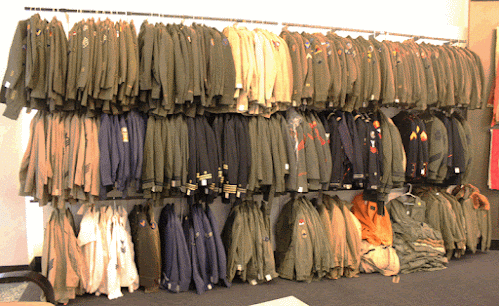The history of World War 1 British army uniforms
The army uniforms worn by soldiers during World War 1 were a reflection of the technology and warfare of the time, as well as the specific needs of each country's military. In this article, we'll explore the history of World War I army uniforms and their evolution over time.
At the start of Great War 1 (WWI), most soldiers wore a traditional army uniform that was based on a particular style or color that was associated with their country. For example, German soldiers wore a distinctive field grey uniform - the German Luftwaffe uniform (German Air Force), while British army soldiers wore a khaki uniform. These WW1 British army uniforms were generally made from wool, which made them warm and durable but also heavy and uncomfortable to wear for long periods of time.
As the war progressed, the need for more specialized army uniforms and gears arose. For example, soldiers who were fighting in trenches needed a uniform that could protect them from mud and rain, so the British developed the "trench coat" - a long, waterproof coat that could be worn over the uniform. Similarly, soldiers who were fighting in desert regions needed a lighter, more breathable uniform that could help them stay cool in the heat.
One of the most significant developments in World War 1 army uniforms was the introduction of body armor. While some soldiers had worn armor in previous wars, the armor used during World War 1 was much more advanced. The British developed a "bulletproof vest" made from layers of silk and steel that were effective at stopping bullets, while the Germans developed a "plate carrier" that could protect the chest and back.
The use of gas in warfare also had a major impact on World War 1 army uniforms. In response to the threat of gas attacks, soldiers were issued gas masks and protective clothing that could help them avoid the worst effects of the gas. The gas masks were often uncomfortable and difficult to breathe through, and the clothing could be hot and cumbersome, but they were essential for survival on the battlefield.
Overall, the history of World War 1 army uniforms is a complex and fascinating one that reflects the changing needs of soldiers during the war. From the basic wool uniforms of the early days to the specialized body armor and gas masks of the later years, each uniform was designed to help soldiers survive and succeed in the unique conditions of World War 1.
The British Army played a major role in World War 1, and the WWI British army uniform and gear were crucial to their success on the battlefield. In this article, we'll take a closer look at the British Army uniform and gear during World War 1.
Uniform:
At the start of World War 1, British army soldiers wore a khaki uniform that was made of wool and included a jacket, trousers, and puttees (long strips of cloth that were wrapped around the lower leg). The uniform also included a helmet made of leather and cloth, known as the "Brodie helmet." The helmet was designed to protect soldiers from shrapnel and other debris.
As the war progressed, the British Army made several changes to the uniform to better suit the needs of soldiers in the field. One of the most significant changes was the introduction of the "trench coat," a long, waterproof coat that was worn over the uniform to protect soldiers from the mud and rain in the trenches. The coat was often lined with wool to provide extra warmth in cold conditions.
Gear:
In addition to the uniform, British soldiers were issued several pieces of war gear that were essential for survival on the battlefield. These included:
Rifle: The standard rifle used by British soldiers during World War 1 was the Lee-Enfield .303 rifle. The rifle was reliable and accurate, and was used by soldiers in all theaters of the war.
Bayonet: The Lee-Enfield rifle also included a bayonet, a long knife that could be attached to the end of the rifle. The bayonet was used in close combat and was a fearsome weapon on the battlefield.
Gas mask: In response to the threat of gas attacks, British soldiers were issued gas masks that could help them avoid the worst effects of gas. The gas masks were often uncomfortable and difficult to breathe through, but they were essential for survival on the battlefield.
Backpack: British soldiers carried a backpack that contained essential items such as food, water, ammunition, and personal items. The backpack was often heavy and cumbersome, but it was necessary for soldiers to carry everything they needed for survival.
Overall, the WWI British Army uniform and gear during World War 1 were designed to meet the specific needs of soldiers on the battlefield. From the khaki uniform of the early days to the specialized trench coats and gas masks of later years, each piece of equipment played a crucial role in helping British soldiers succeed in the challenging conditions of World War 1.

.jpeg)



Comments
Post a Comment